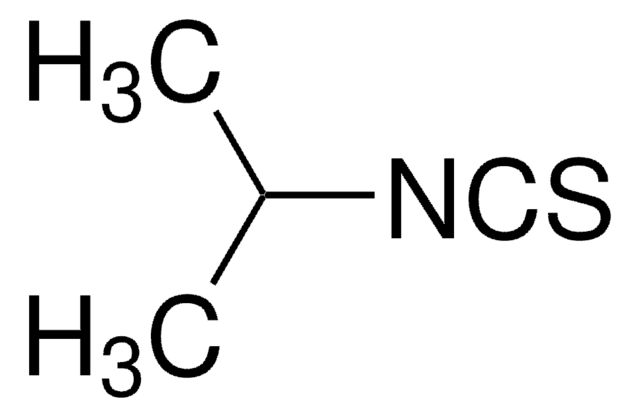377430
Allyl isothiocyanate
95%
Synonym(s):
AITC, Oil of mustard
About This Item
Recommended Products
Assay
95%
form
liquid
contains
BHT as stabilizer
refractive index
n20/D 1.529 (lit.)
bp
150 °C (lit.)
mp
−80 °C (lit.)
density
1.013 g/mL at 25 °C (lit.)
storage temp.
2-8°C
SMILES string
C=CCN=C=S
InChI
1S/C4H5NS/c1-2-3-5-4-6/h2H,1,3H2
InChI key
ZOJBYZNEUISWFT-UHFFFAOYSA-N
Looking for similar products? Visit Product Comparison Guide
Application
- Quantitation of the N-acetylcysteine conjugate of AITC in human urine after ingestion of mustard.
- Evaluation of the fungitoxic activity of AITC vapour on Penicillium expansum on pears, particularly on a thiabendazole (TBZ)-resistant P. expansum strain in vivo, to verify whether AITC treatment could be a substitute for TBZ.
- Study of the induction of acetylation of histone in mouse erythroleukemia cells by some organosulfur compounds.
Biochem/physiol Actions
Signal Word
Danger
Hazard Statements
Precautionary Statements
Hazard Classifications
Acute Tox. 2 Dermal - Acute Tox. 2 Inhalation - Acute Tox. 4 Oral - Aquatic Acute 1 - Aquatic Chronic 1 - Eye Dam. 1 - Flam. Liq. 3 - Skin Corr. 1B - Skin Sens. 1
Storage Class Code
3 - Flammable liquids
WGK
WGK 3
Flash Point(F)
113.0 °F - closed cup
Flash Point(C)
45 °C - closed cup
Certificates of Analysis (COA)
Search for Certificates of Analysis (COA) by entering the products Lot/Batch Number. Lot and Batch Numbers can be found on a product’s label following the words ‘Lot’ or ‘Batch’.
Already Own This Product?
Find documentation for the products that you have recently purchased in the Document Library.
Customers Also Viewed
Our team of scientists has experience in all areas of research including Life Science, Material Science, Chemical Synthesis, Chromatography, Analytical and many others.
Contact Technical Service












